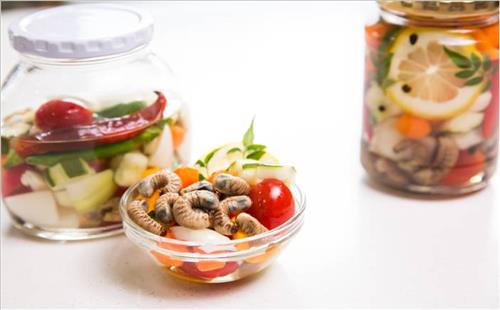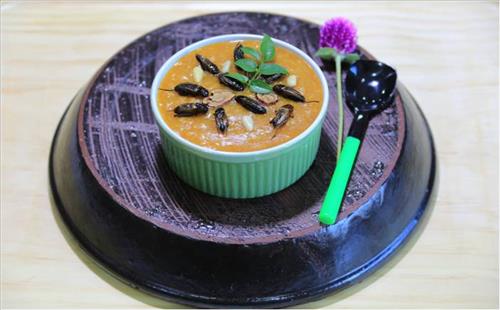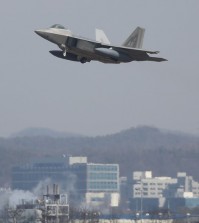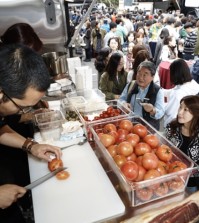- California Assembly OKs highest minimum wage in nation
- S. Korea unveils first graphic cigarette warnings
- US joins with South Korea, Japan in bid to deter North Korea
- LPGA golfer Chun In-gee finally back in action
- S. Korea won’t be top seed in final World Cup qualification round
- US men’s soccer misses 2nd straight Olympics
- US back on track in qualifying with 4-0 win over Guatemala
- High-intensity workout injuries spawn cottage industry
- CDC expands range of Zika mosquitoes into parts of Northeast
- Who knew? ‘The Walking Dead’ is helping families connect
S. Korea tests bugs as future food, but perception gnaws
By Lee Minji
SEOUL (Yonhap) — Grasshopper croquette served with mealworm coffee sherbet, beetle powder-crusted fried chicken, and sweet pumpkin porridge topped with dried cricket, pickled larva and assorted vegetables.
These are some of the recipes submitted to a government-hosted insect cooking contest late last month as South Korea experiments with the culinary potential of six-legged creatures.
The event was the latest of Seoul’s efforts to foster the insect industry as it searches for new sources of livestock and ways to help cash-strapped farms find new profit makers.
In 2010, the government announced the legislation of a special law aimed at fostering the insect industry, valued at 168 billion won (US$151 million) in 2011 and forecast to reach 298 billion won next year.
In the following year, the agriculture ministry introduced a five-year roadmap to meet the goal by pushing the research and development of edible and cookable insects and supporting farms that raise eligible species.
Since then, the government has temporarily authorized two insect species — darkling beetle and caterpillar larva — as legitimate food ingredients that are safe for consumption and nutritionally appropriate.
“The insect industry had mainly focused on academic purposes or raising them (insects) as pets. But now, they are considered an important resource for future food supply,” said Yun Eun-young, a researcher at the state-run Rural Development Administration.
The Food and Agriculture Organization (FAO) highlighted the potential of insects in a 2013 report where it recommended edible bugs as one of the “innovative solutions” that could help ease demand for livestock products that is forecast to double between 2000 and 2050.
“The opportunity for insects to help meet rising demand in meat products and replace fishmeal and fish oil is enormous,” the U.N. agency said in a report titled “Edible insects: Future prospects for food and feed security.”
Other advocates of “entomophagy,” or consuming insects as food, stress the practical side of the unconventional diet: its high nutritional value.
The darkling beetle, for instance, is 21.9 percent fat, of which 70-80 percent is unsaturated fat, according to the 2013 report European Novel Food. A handful of species, such as the caterpillar larva, have been used as medical supplements in oriental medicine.
Experts, however, point out that squeamishness about edible insects may thwart ambitious efforts to incorporate the creatures into the daily diet of Koreans who are known for their bold tolerance of exotic delicacies.
Young Koreans grow up eating seasoned silkworm as picnic snacks, and locals are nonchalant about eating cooked fish in their original form, including the head. But even for them, the idea of eating beetles and larva is not all that appetizing.
“I wouldn’t necessarily try it. I would if I was forced to take it as medicine, but otherwise, I feel disgusted by the notion (of eating insects),” said Jeon Euri, a 28-year-old from Seoul who regularly treats herself to grilled beef intestines and braised pork feet.
“While the nutritional value is big, people shun edible insects due to the wrong perception. We are trying to promote it by making them more familiar by holding cooking contests and sampling sessions,” said Lee Jeong-yong, head of research at Worldway, a food producer that has been commissioned to manufacture edible insect ingredients.
Lee’s company recently expanded the sale of processed insects, such as insect powder, to retail consumers from wholesale retailers. A 200-gram packet of ground darkling beetle costs roughly 50,000 won, which is not a small sum of money compared with other food ingredients.
“It’s true that the cost is high due to fixed cost and a complicated sterilization process. But if demand grows, we will eventually be able to sell them at a lower cost. Perceptions would have to change for that,” said Lee, declining to give sales figures citing the nascent market.
Choi Soo-keun, one of South Korea’s first chefs to be trained at the Le Cordon Bleu, said demand for such insect ingredients may grow, but only if perceptions improve.
“People who were reluctant to try actually reacted positively after tasting the food. They said it adds a nutty savor,” said Choi who has invented and showcased recipes such as mango ade with darkling beetle powder and rucola pizza topped with darkling beetle chunks.
A recent showcase at the government-run cooking competition was also successful.
“I thought it would be odd, but it adds a fun twist to the food. I’d definitely try it again if there are places that sell it,” said 30-year-old Cho Sang-min as he tasted cotton candy coated with darkling beetle powder.
Veteran chef Choi, however, added that the addition of edible insects to the local diet will not be a predictable nor short journey.
“Even after regulatory and sanitary hurdles have been cleared, we have to see how things turn out. It usually takes a few decades or even a century for certain food ingredients to settle down in a society,” he said.


















Pingback: S. Korea tests bugs as future food, but percept...
Pingback: How To Cook Korean Pumpkin Porridge | all pasta recipes
Pingback: How To Cook Korean Pumpkin Porridge | book - how to cook
Pingback: How To Cook Korean Pumpkin Porridge | ribs - bbq recipes
kelly
November 25, 2017 at 3:11 PM
yes..I like the basic concepts behind Second Life but it seems incredibly outdated and when I played it was intensely non-intuitive / user friendly to an extent that made EVE look like a game for toddlers. thanks from
togel online